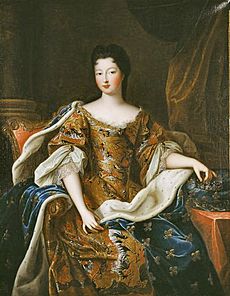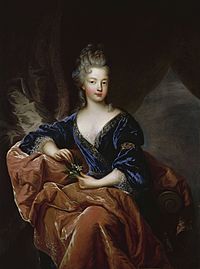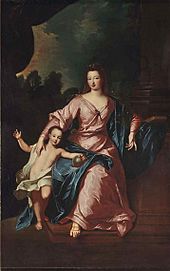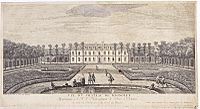Françoise Marie de Bourbon facts for kids
Quick facts for kids Françoise Marie de Bourbon |
|
|---|---|
| Légitimée de France Duchess of Orléans |
|

Pierre Gobert, "Portrait of the Duchess of Orléans Françoise Marie de Bourbon", 1700
|
|
| Born | 4 May 1677 Château de Maintenon, Maintenon, France |
| Died | 1 February 1749 (aged 71) Palais-Royal, Paris, France |
| Burial | 6 February 1749 Église de la Madeleine de Trainel, Paris, France |
| Spouse | |
| Issue Detail |
|
| House | Bourbon |
| Father | Louis XIV |
| Mother | Madame de Montespan |
| Signature | |
Françoise Marie de Bourbon (born May 4, 1677 – died February 1, 1749) was a French princess. She was the youngest daughter of King Louis XIV of France and his official mistress, Françoise-Athénaïs de Rochechouart, Marquise de Montespan.
When she was 14, Françoise Marie married her cousin, Philippe d'Orléans. He later became the regent of France, ruling the country while Louis XV was too young to be king. Through her children, Françoise Marie became an ancestor of many European kings and queens. These included rulers of Belgium, Italy, Portugal, Spain, and France.
Françoise Marie did not have much political power. She was involved in a plot in 1718 called the Cellamare conspiracy. This plot tried to remove her husband as regent and replace him with her brother, Louis-Auguste, Duke of Maine. The plot failed.
Contents
Early Life and Family (1677–1692)
Françoise Marie was born in 1677 at the Château de Maintenon. This castle was owned by Françoise d'Aubigné, Marquise de Maintenon. She was the governess for the king's children born outside of marriage.
Françoise Marie and her younger brother, Louis Alexandre de Bourbon, were cared for by several women under Madame de Maintenon's watch. Their mother, Madame de Montespan, was later not allowed at court. Françoise Marie sometimes visited her parents at the Palace of Versailles.
Becoming Mademoiselle de Blois
On November 22, 1681, when Françoise Marie was four years old, King Louis XIV officially recognized her as his daughter. This process is called legitimisation. He gave her the title Mademoiselle de Blois. This title had been used by her older half-sister, Marie Anne de Bourbon.
Louis XIV did not mention Françoise Marie's mother in the official document. This was because Madame de Montespan was still married to someone else. Her husband might have claimed to be the father of the children. Around the time Françoise Marie was born, her parents' relationship was ending. This was partly due to a scandal called the Affair of the Poisons.
Her older siblings, Louis Auguste and Louise Françoise, had been legitimised earlier. Her younger brother, Louis Alexandre, was legitimised at the same time as her. He became the comte de Toulouse. Françoise Marie remained close to these two brothers throughout her life. However, she was never close to her legitimate half-brother, Louis, Dauphin of France.
Françoise Marie was known for her beauty, like her mother. People said she was "a little beauty with a beautiful face." She was very proud of her royal family background. She often reminded people that she was a "daughter of France."
Marriage to Philippe d'Orléans

Madame de Maintenon, who was like a stepmother to Françoise Marie, helped arrange her marriage. She managed to get Françoise Marie married to the king's only legitimate nephew, Philippe d'Orléans. This marriage caused a scandal at court because Françoise Marie was born outside of marriage.
Philippe's mother, Elizabeth Charlotte, was very upset. She did not like the king's children born outside of marriage. When she heard her son agreed to the marriage, she slapped him in front of everyone. She also turned her back on the king. She remained an enemy to Françoise Marie and didn't care much for her grandchildren.
For the wedding, Louis XIV gave his brother the Palais-Royal in Paris. This palace was where the Orléans family lived, but they didn't own it. The king also promised Philippe an important military job. He gave a large sum of money to Philippe's favorite friend.
Françoise and Philippe d'Orléans were married on February 18, 1692. The ceremony took place in the chapel at the Palace of Versailles. After the wedding, a big dinner was held in the Hall of Mirrors. Many important people attended, including the exiled James II of England. Madame de Montespan, Françoise Marie's mother, was not invited to the wedding.
Because her husband was a legitimate grandson of a king, Françoise Marie gained the title of petite-fille de France (Grand-Daughter of France). She was addressed as Royal Highness. She also had special privileges, like dining with the king. As the new duchesse de Chartres, she was very important at court.
Françoise Marie received a large dowry from her father, more than two million livres. This was twice the amount given to her older sister, Louise. This difference caused some bad feelings between the sisters.
Soon after their marriage, Philippe often made fun of his wife's bad temper. He even called her Madame Lucifer. Despite their disagreements, they had eight children. Many of their children later married into other royal families in Europe.
Duchess of Orléans (1701–1749)
In 1701, Philippe's father died. This made Philippe the Duke of Orléans and the head of the Orléans family. Françoise Marie became the Duchess of Orléans. She now had higher importance than her mother-in-law at court.
Her husband and she lived a very grand lifestyle at the Palais-Royal in Paris and the Château de Saint-Cloud. They hired famous artists to decorate their homes.
While her husband enjoyed a lively social life, Françoise Marie lived a quiet life. She avoided scandals, unlike her sisters. She preferred the company of her cousins and close friends.
In 1707, Françoise Marie's mother passed away. Her father, the king, did not allow his children born outside of marriage to wear mourning clothes for their mother. However, Françoise Marie and her siblings chose not to attend court events during this time.
In 1710, Françoise Marie arranged for her oldest daughter, Marie Louise Élisabeth d'Orléans, to marry Charles, Duke of Berry. He was King Louis XIV's youngest legitimate grandson. This marriage made her daughter very important at court.
When King Louis XIV died in 1715, his great-grandson, Louis XV, became the new king at age five. There was a disagreement between Françoise Marie's brother and her husband about who would rule as regent. The court decided that her husband, the Duke of Orléans, would be the regent.
As the regent's wife, Françoise Marie became the most important lady in France. Her husband increased her yearly allowance. In 1719, she bought the Château de Bagnolet near Paris. She expanded the small castle with the help of an architect.
Family Life and Later Years
Françoise Marie tried to arrange marriages for two of her daughters with her cousin, the Duke of Maine's son. However, both daughters refused.
In 1721, she arranged for two other daughters, Louise Élisabeth and Philippine Élisabeth, to marry into the Spanish royal family. Louise Élisabeth married the heir to the Spanish throne, Infante Luis Felipe. Philippine Élisabeth married Luis Felipe's younger half-brother. Philippine Élisabeth's marriage was later cancelled, and she returned to France. She died in 1734.
After her husband died in December 1723, Françoise Marie lived a more private life at Saint-Cloud.
In 1725, King Louis XV married Marie Leszczyńska. This meant Françoise Marie's importance at court decreased. However, Françoise Marie got along well with Queen Marie. She often hosted parties for the Queen at her castles. The Queen also visited Françoise Marie's palaces and asked for her advice on court manners.
One of the king's daughters, Madame Henriette, fell in love with Françoise Marie's grandson, Louis Philippe. But King Louis XV did not allow them to marry. He did not want the Orléans family to become too powerful.
So, Françoise Marie had to find another bride for her grandson. She arranged for him to marry her niece, Louise Henriette de Bourbon. This marriage connected Françoise Marie's family with her sister's family, even though they had been rivals. Françoise Marie lived to see the birth of her great-grandson, Philippe Égalité, in 1747.
Her youngest daughter, Louise Diane, married Louis François de Bourbon. Sadly, Louise Diane died while giving birth. Her only surviving child later married Princess Maria Fortunata of Modena. Maria Fortunata was a daughter of Françoise Marie's difficult daughter, Charlotte Aglaé. Charlotte Aglaé often left Modena and returned to France, but Françoise Marie and her son chose to ignore her during these times.
Death
Françoise Marie died on February 1, 1749, at the Palais-Royal. She was 71 years old and had been ill for a long time. She was the last surviving child of King Louis XIV. She outlived her husband by twenty-six years. Her children Charlotte Aglaé and Louis, Duke of Orléans, were still alive when she passed away.
She was buried at the Church of Madeleine de Traisnel in Paris on February 6. Her heart was taken to the Val-de-Grâce.
Today, a small portrait of Françoise Marie by the painter Rosalba Carriera is part of the Royal Collection of the British Royal Family.
Issue
- Mademoiselle de Valois (December 17, 1693 – October 17, 1694); died as a baby.
- Marie Louise Élisabeth d'Orléans (August 20, 1695 – July 21, 1719); married Charles of France, Duke of Berry. All her children died as babies.
- Louise Adélaïde d'Orléans (August 13, 1698 – February 10, 1743); became a nun and Abbess of Chelles. She never married or had children.
- Charlotte Aglaé d'Orléans (October 22, 1700 – January 19, 1761); married Francesco III d'Este, Duke of Modena. She had children.
- Louis d'Orléans (August 4, 1703 – February 4, 1752); married Margravine Johanna of Baden-Baden. He had children.
- Louise Élisabeth d'Orléans (December 11, 1709 – June 16, 1742); married Louis I of Spain. She had no children.
- Philippine Élisabeth d'Orléans (December 18, 1714 – May 21, 1734); she never married and had no children.
- Louise Diane d'Orléans (June 27, 1716 – September 26, 1736); married Louis François de Bourbon. She had children.
See also
 In Spanish: Francisca María de Borbón para niños
In Spanish: Francisca María de Borbón para niños




